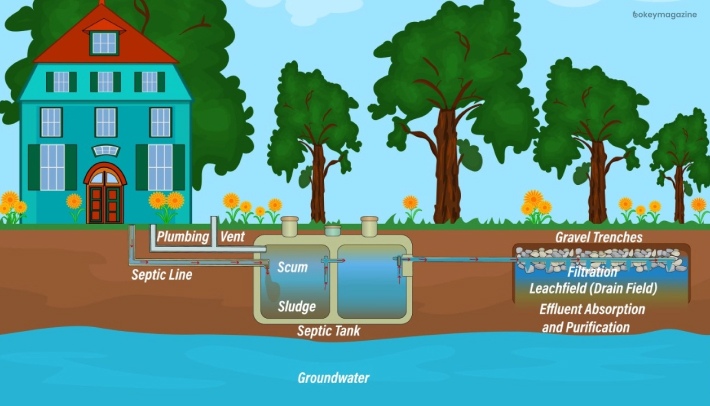
Septic Tank: Definition, Uses, Functions, Working and Maintenance
What Is A Septic Tank?

A septic tank is actually an underwater sedimentation tank that is used for wastewater management through drainage and biological decomposition. A septic tank uses proven technology and natural processes for treating wastewater from the household – produced by laundry, drains, kitchen drains, and bathrooms.
These are known to have a simple relative design. They are underground watertight containers made of concrete, glass, or plastic.
Types Of Septic Tanks

The size and design of a septic tank can greatly vary widely, from within a neighborhood to one across the country, because of a combination of many factors. Hence there are many types of septic systems. Here are the common forms of septic tank installation that are used prevalently:
- Septic Tank
- Aerobic Treatment Unit
- Chamber System
- Conventional System
- Cluster / Community System
- Drip Distribution System
- Recirculating Sand Filter System
- Mound Systems
- Constructed Wetland System
- Evapotranspiration System
- Cluster / Community System
How Do They Work?

How does a septic tank work really? – Well, the septic tank actually remains connected to two pipes (an outlet and an inlet). The inlet pipe is used to transport the wastewater from the house and then collected in the septic tank. It is kept there long enough so that the liquid and solid separate from one another. The 2nd pipe is called the outlet pipe, it goes into the drain field.
This pipe is moved from the pre-processed form of wastewater from the septic tank and then spread evenly in the watercourses and soil. After that, when the wastewater gets collected after a while, it separates into three different layers.
The top layer, middle layer, and the bottom layer. There are also bacteria that play a very important role in this as well, it does a job of breaking down the solid waste, which in turn allows the liquids to get separated and drain away. The one left at the bottom of the tank, though, needs to be systematically removed as a form of general septic tank maintenance.
The Workings Of A Septic Tank

Here is a step-by-step guide on how exactly a septic tank works:
| The water from the bathroom, kitchen, drains, etc., runs through the main drainage pipe that leads to the septic tank. |
| The Underground septic tank then starts the process of holding the wastewater and has it long enough for the solids to settle down to the bottom of the tank. All the while, the grease and oil float to the top. |
| After the above-mentioned process gets completed, the wastewater exits the tank and into the drain field. |
| This wastewater is then discharged through the pipes and onto porous surfaces. These allow for the wastewater to screen through to the soil. |
| Then the soil treats after accepting, and then disperses wastewater as it percolates through the soil, ultimately discharging them into the groundwater. |
| Lastly, the wastewater percolates into the soil and naturally removes all the harmful coliform bacteria, nutrients, and viruses. |
Maintenance Of A Septic Tank

Maintenance and septic tank cleaning is not complicated and does not need to be expensive. The proper upkeeping of it comes down to four main elements:
- Use Water Efficiently
All of the water households use is sent down through the pipes and into the septic tank system. The more water a household uses, the more water enters the septic system. If a household uses water efficiently, that would improve the operation of a septic tank system and significantly reduce the risk of malfunctions in the tank.
You can do that by getting high-efficiency toilets at your home – most probably the ones that use less amount of water per flush. You could also install high-efficiency showerheads at your home. These are only a few examples that I mentioned, you can save water in a lot more ways.
Tip: How much does it cost to pump a septic tank? To answer the question, the average costs are set around $400; the lowest that it can go is about $225 for most of the residential tanks.
- Inspect And Pump Frequently
An average household’s septic tank system should be inspected at least every three years by a service professional. Household septic tanks are generally pumped every 3-5 years. There are alternative systems with septic tank pumping, float switches, or even mechanical components – these should be inspected more often, atleast once a year.
- Properly Dispose Off The Waste
No matter where you are flushing the waste from – everything goes down into the septic tank. Whether you pour it down the sink, flush it down the toilet, or bath, everything gets collected into the septic tank.
What goes down the drainage system directly affects the septic tank as well. Do not treat your septic tank as a garbage disposal then; that can cause your septic tank to malfunction as well.
- Maintain The Drainfield
The drain field is the main component of the septic tank that removes contaminants from the liquid that emerges from the septic tank. It is also an important part of the septic tank system, and one should go to great lengths to maintain it.
A few helpful tips that I would give are – you need to make sure that you are not parking any vehicle on your drain field. Also, you need to maintain that you will not be planting any trees on your drain field. Planting trees in such a space would allow for the roots to grow into the septic tank.
To Wrap It Up!
That was all for information regarding the workings of septic tanks. Thank you for reading up till here. I hope you found the information useful. Let me know in the comments your thoughts on the same.
Explore More:



















Post Your Comment